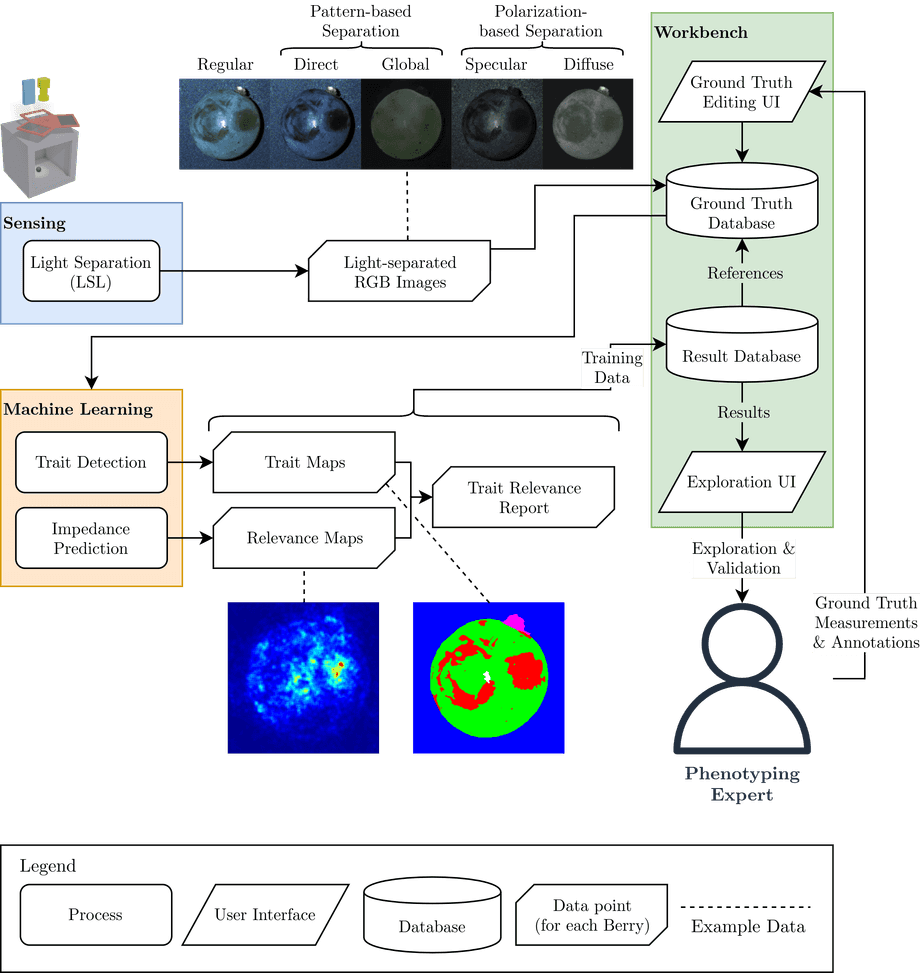Improved optical phenotyping of the grape berry surface using light-separation and automated RGB image analysis
Abstract
Grape resilience towards Botrytis cinerea (B. cinerea) infections (Botrytis bunch rot) is an important concern of breeders and growers. Beside grape bunch architecture, berry surface characteristics like berry bloom (epicuticular wax) as well as thickness and permeability of the berry cuticle represent the most promising physical barriers to increase resilience towards Botrytis bunch rot. In previous studies, two efficient sensor-based phenotyping methods were developed to evaluate both berry surface traits fast and objectively: (1) light-separated RGB (red-green-blue) image analysis to determine the distribution of epicuticular wax on the berry surface; and (2) electrical impedance characteristics of the grape berry cuticle based on point measurements.
The present proof-of-concept study aiming at the evaluation of light-separated RGB images for both phenotyping applications, phenotyping wax distribution pattern and berry cuticle impedance values. Within the selected grapevine varieties like Riesling, Sauvignon Blanc or Calardis Blanc five contributions were achieved: (1) Both phenotyping approaches were fused into one prototypic unified phenotyping method achieving a wax detection accuracy of 98.6% and a prediction of electrical impedance with an accuracy of 95%. (2) Both traits are derived using only light-separated images of the grapevine berries. (3) The improved method allows the detection and quantification of additional surface traits of the grape berry surface such as lenticels (punctual lignification) and the berry stem that are also known as being able to affect the grape susceptibility towards Botrytis. (4) The improved image analysis tools are further integrated into a comprehensive workbench allowing end-users, like breeders to combine phenotyping experiments with transparent data management offering valuable services like visualizations, indexing, etc. (5) Annotation work is supported by a sophisticated annotation tool of the image analysis workbench. The usage of light-separated images enables fast and non-invasive phenotyping of different optical berry surface characteristics, which saves time-consuming labor and additionally allows the reuse of the berry samples for subsequent investigations, e.g. Botrytis infection studies.

Figure: Overall workflow of the phenotyping processes and the data management workbench
Cite
In plaintext:
Haucke, T., Herzog, K., Barré, P., Höfle, R., Töpfer, R., & Steinhage, V. (2021). Improved optical phenotyping of the grape berry surface using light-separation and automated RGB image analysis. Vitis, 60(1), 1–10. https://doi.org/10.5073/vitis.2021.60.1-10
In BibTeX:
@article{haucke2021improved,
title={Improved optical phenotyping of the grape berry surface using light-separation and automated RGB image analysis},
author={Haucke, Timm and Herzog, Katja and Barr{\'{e}}, Pierre and H{\"o}fle, Rebecca and T{\"o}pfer, Reinhard and Steinhage, Volker},
doi={https://doi.org/10.5073/vitis.2021.60.1-10},
journal={Vitis},
volume={60},
number={1},
pages={1--10},
year={2021},
publisher={JKI-Institute for Grapevine Breeding Geilweilerhof, D-76833 Siebeldingen, Germany},
url={https://ojs.openagrar.de/index.php/VITIS/article/view/15360}
}
License: This work is licensed under a Creative Commons Attribution 4.0 International License.